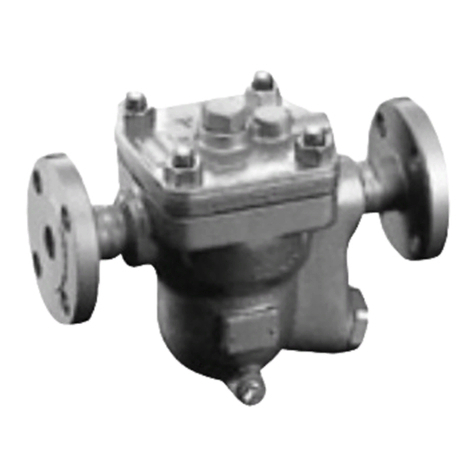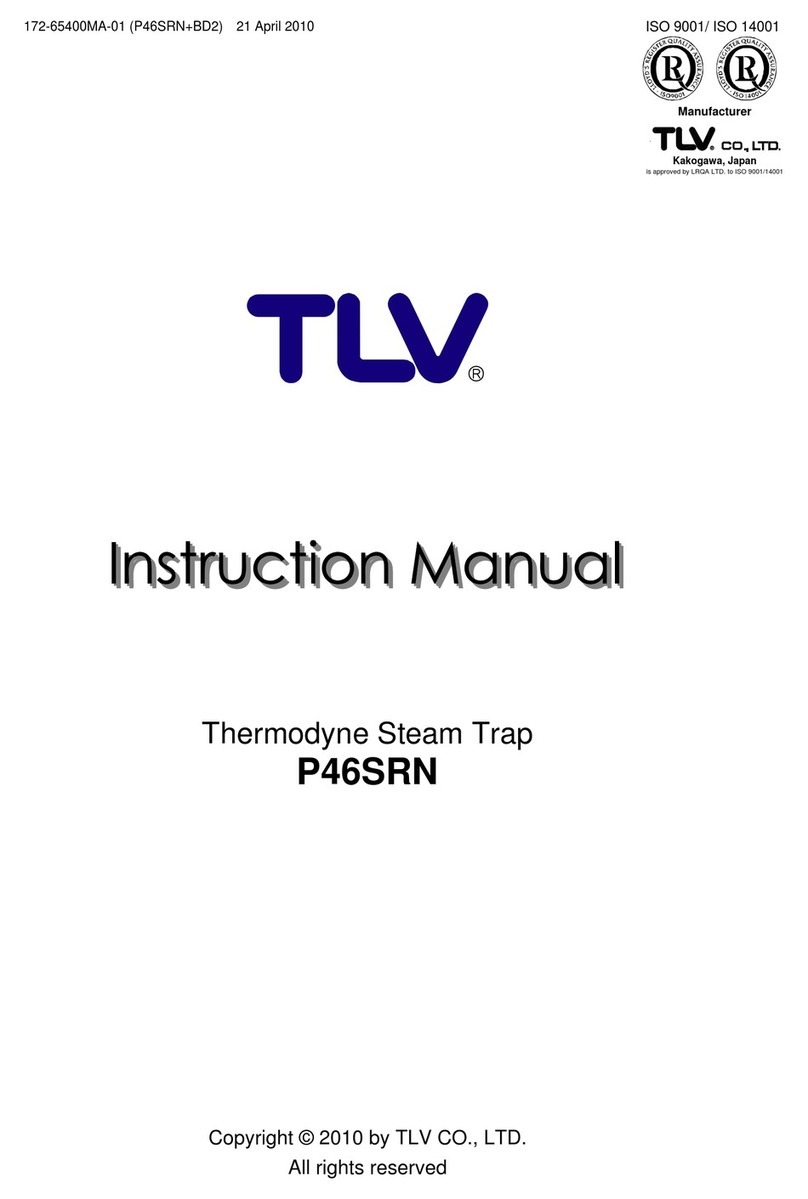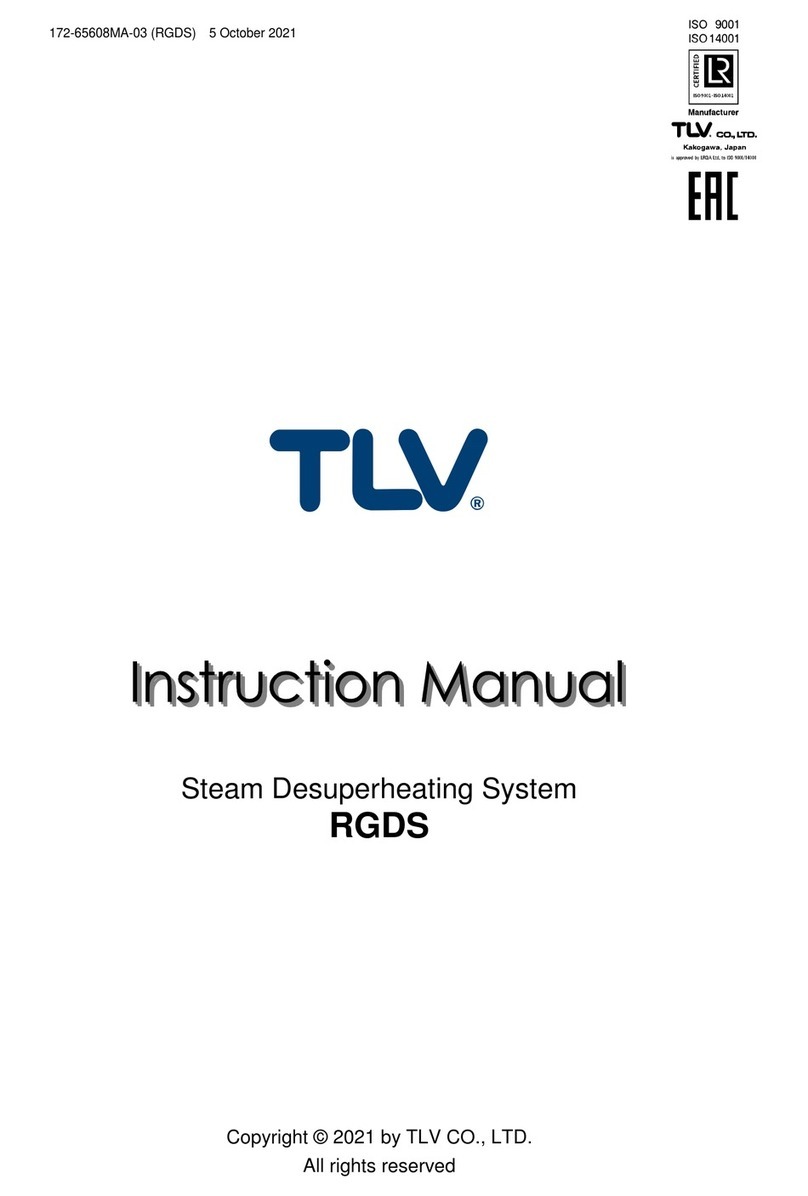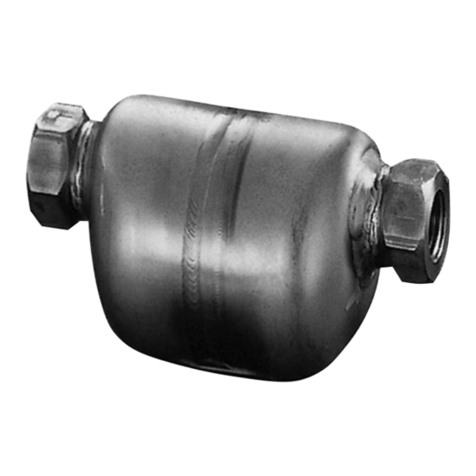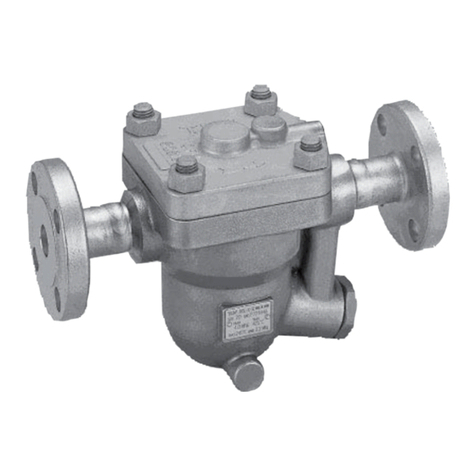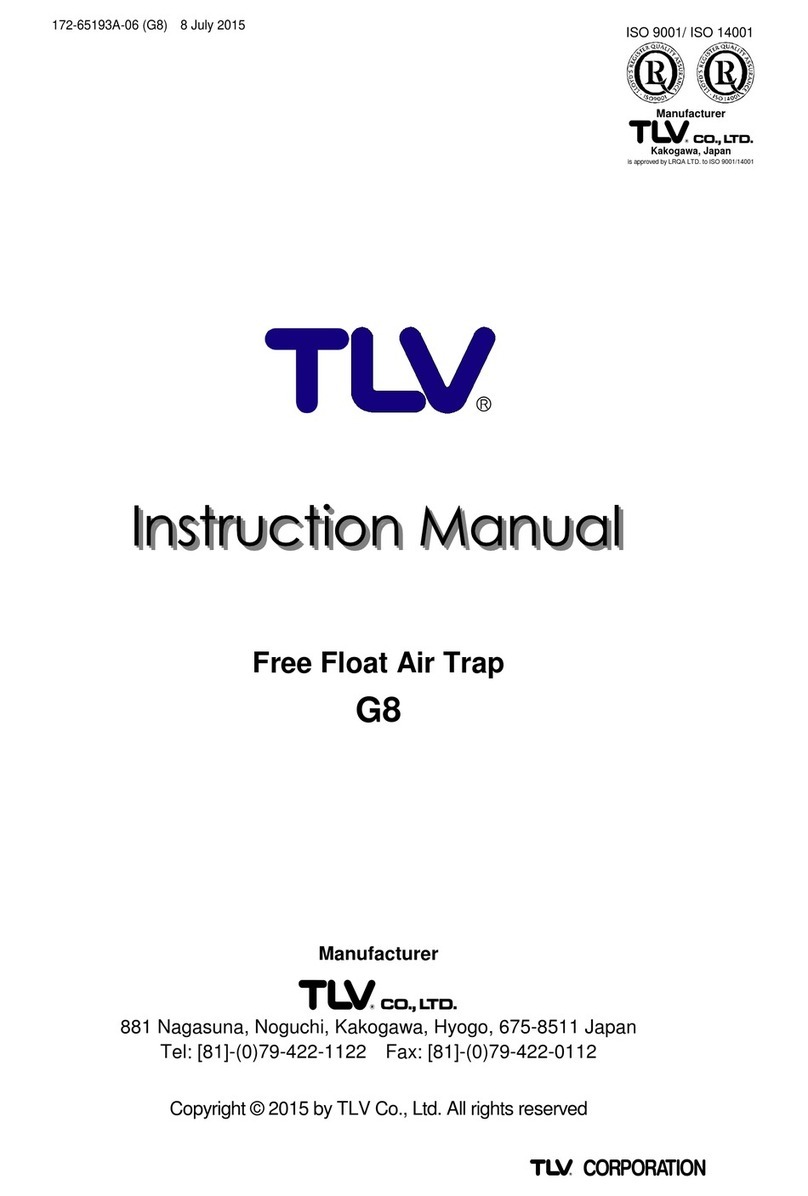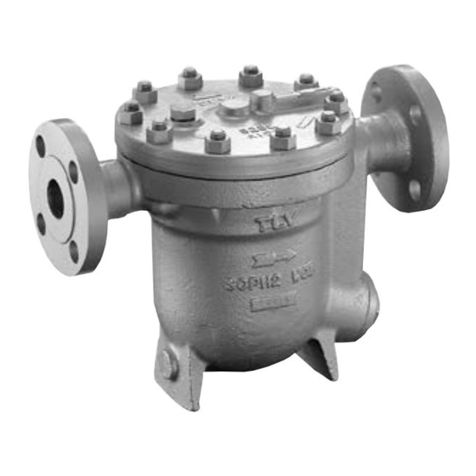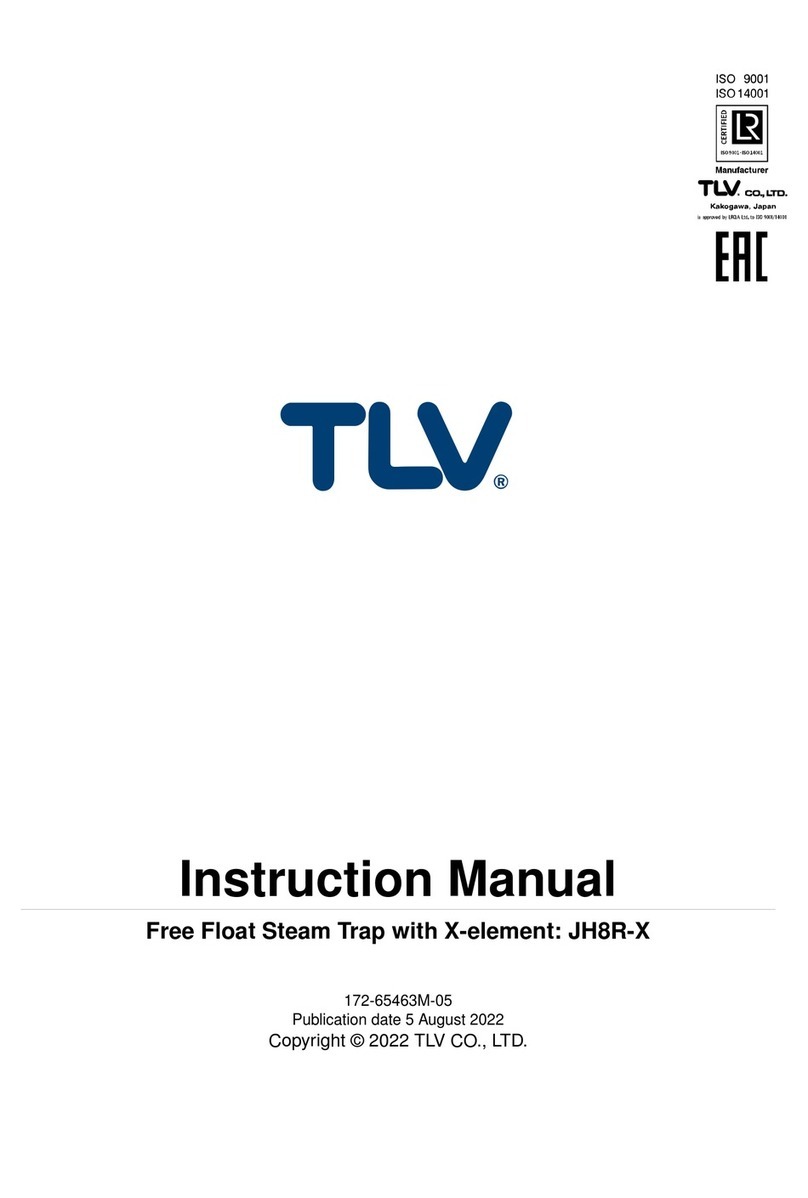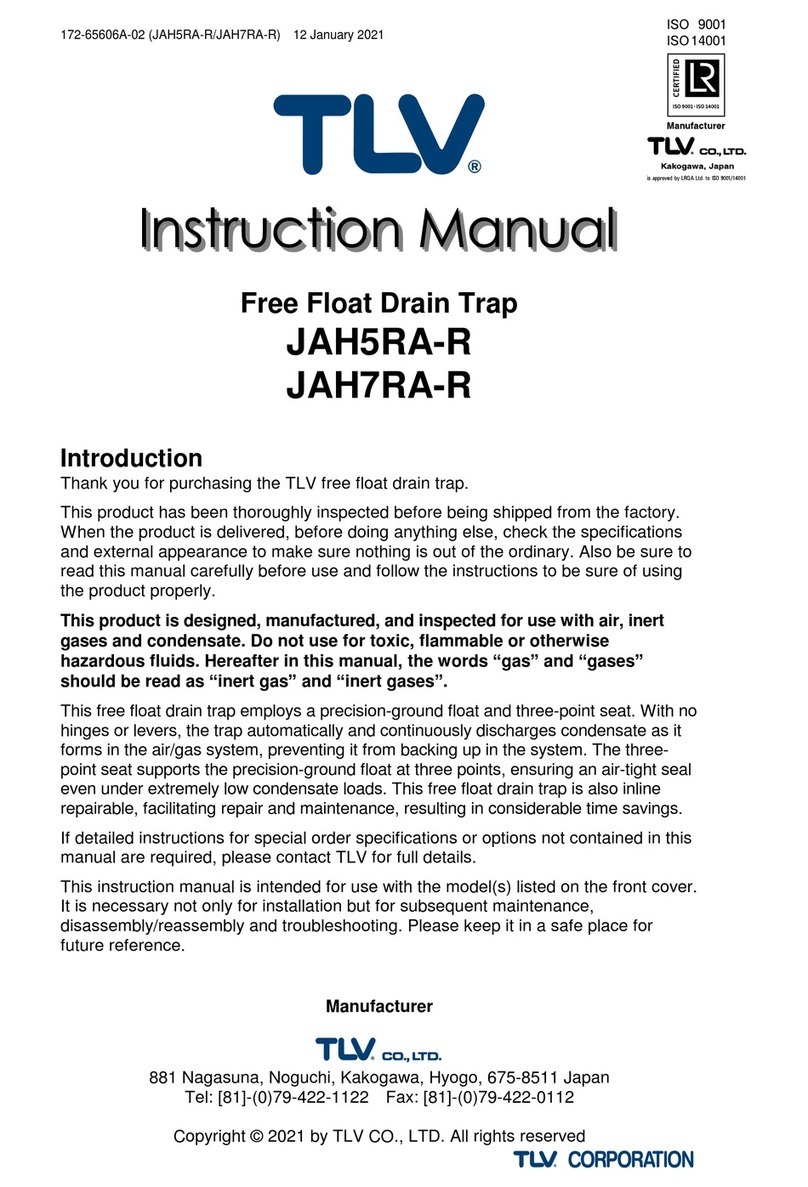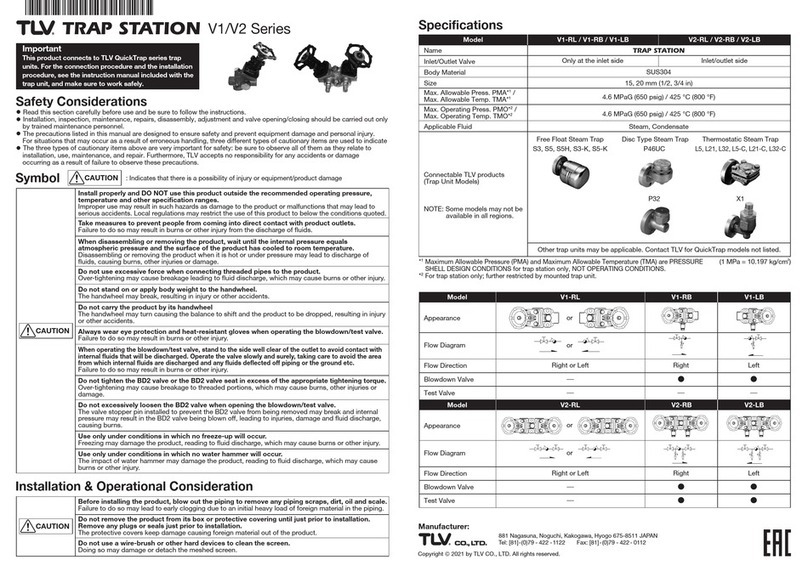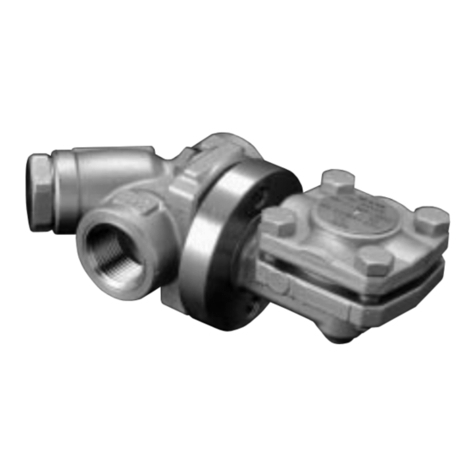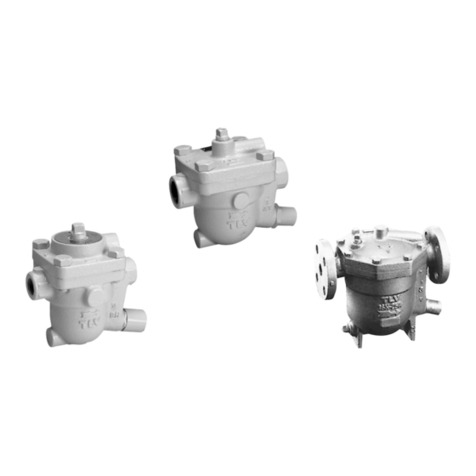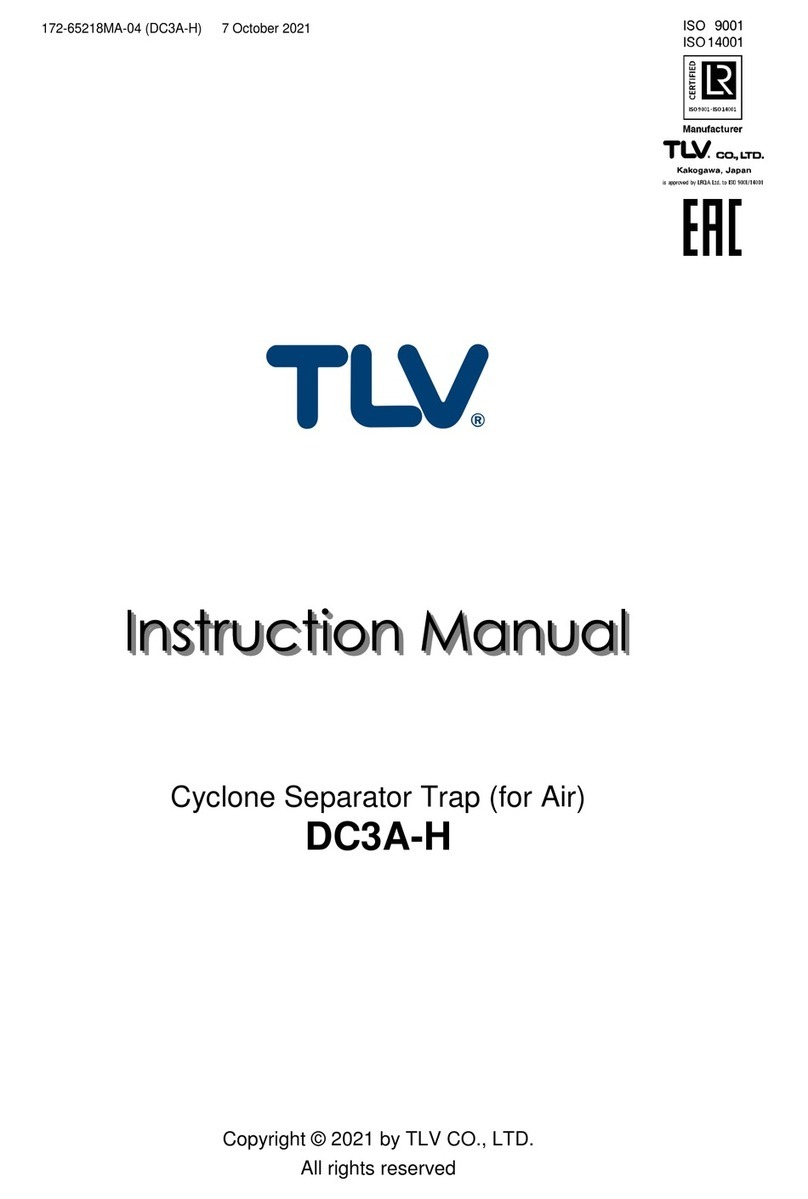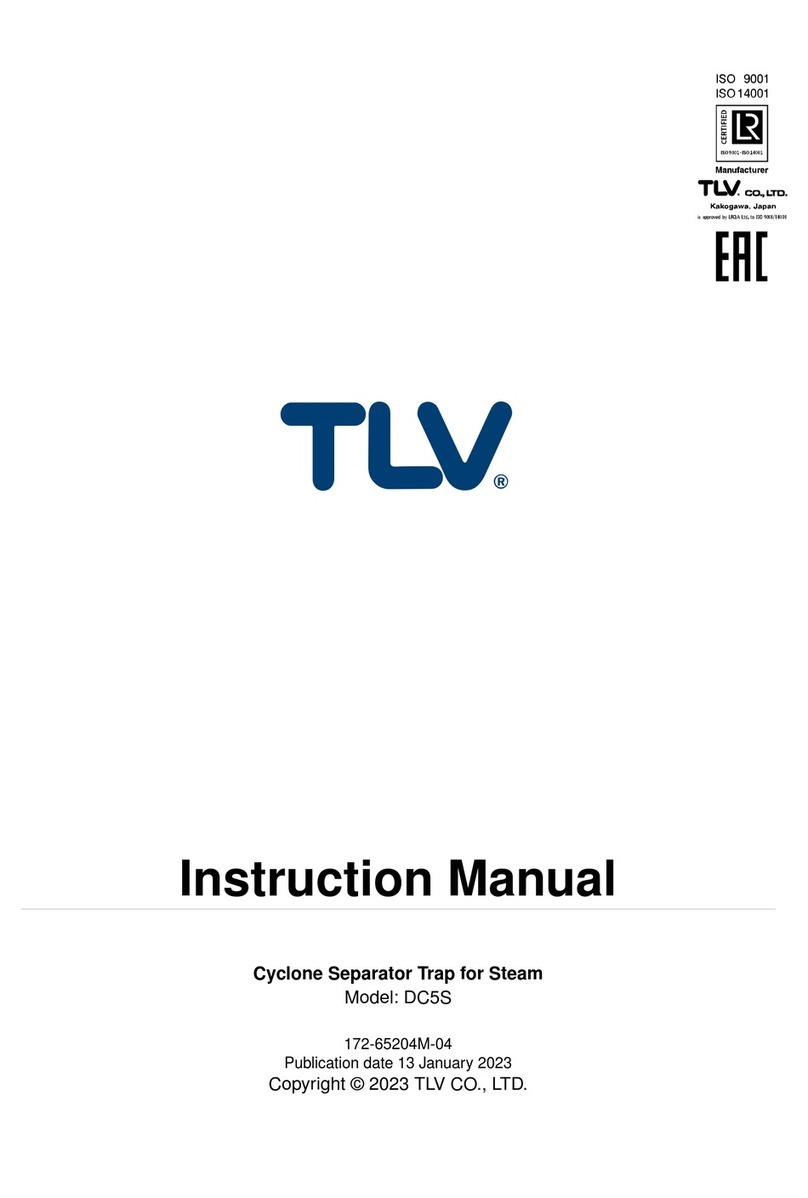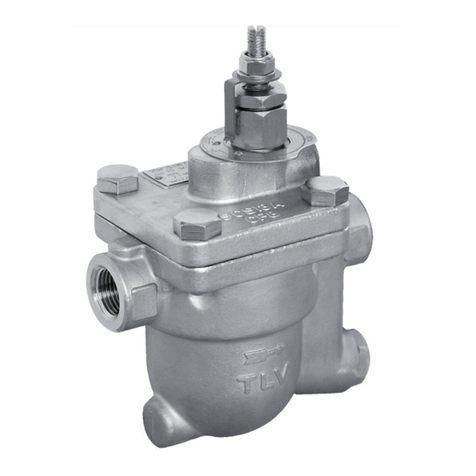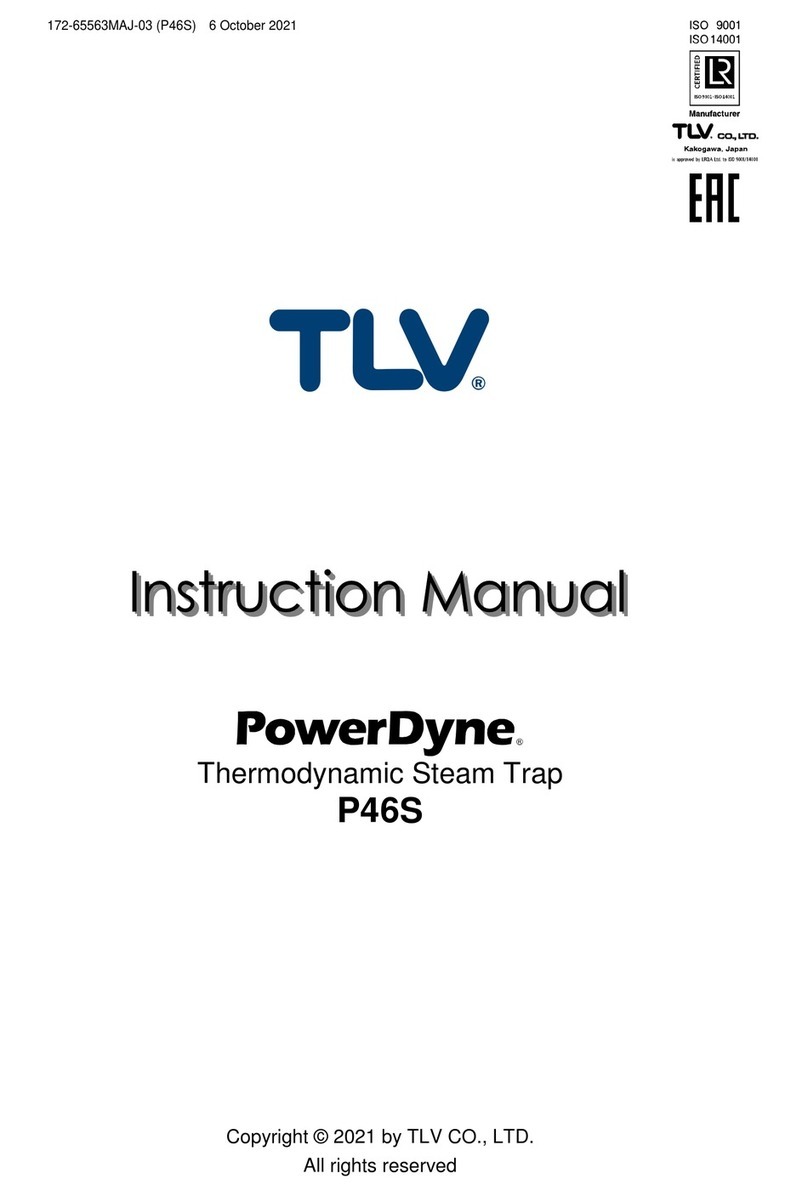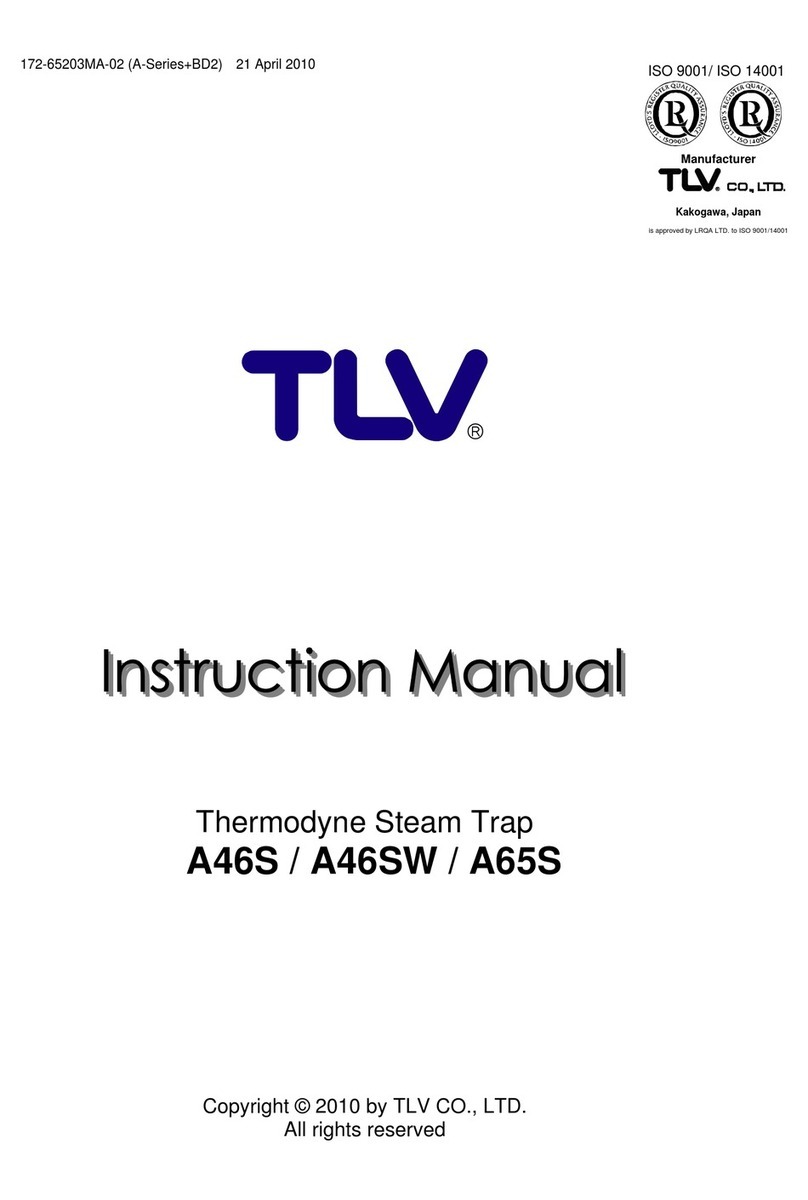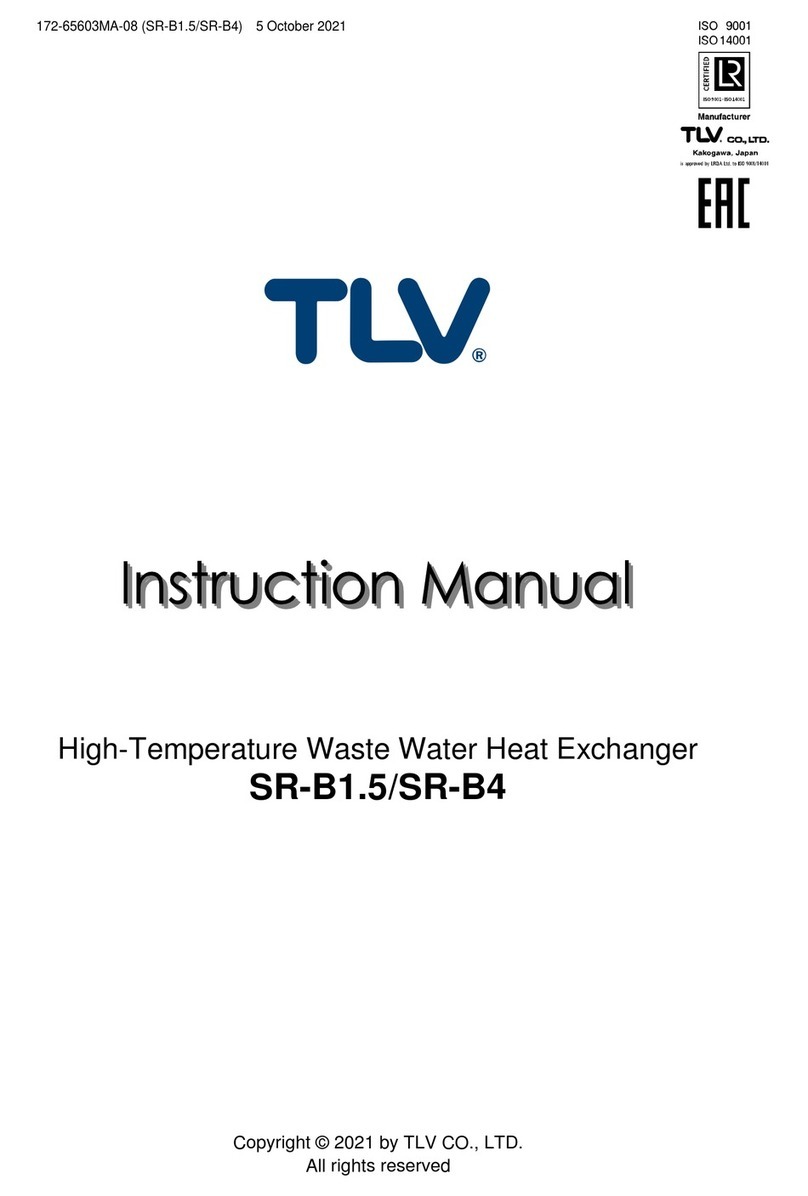TLV SS1VG-M User manual

172-65393MA-03 (SS1VG) 4 August 2015
Free Float Drain Trap
SS1VG-M / SS1VG-R
Copyright © 2015 by TLV CO., LTD.
All rights reserved
ISO 9001/ ISO 14001
Manufacturer
Kakogawa, Japan
is approved by LRQA LTD. to ISO 9001/14001

172-65393MA-03 (SS1VG) 4 Aug 2015
1
Contents
Introduction ....................................................................... 1
Safety Considerations....................................................... 2
Checking the Piping.......................................................... 4
Specifications.................................................................... 5
Configuration..................................................................... 6
Installation......................................................................... 7
The Need for a Pressure-balancing Line .......................... 8
Secondary Side Precautions............................................. 8
Maintenance...................................................................... 9
Disassembly / Reassembly............................................. 10
Troubleshooting .............................................................. 12
Product Warranty ............................................................ 13
Introduction
Thank you for purchasing the Free Float Drain Trap.
This product has been thoroughly inspected before being shipped from the factory.
When the product is delivered, before doing anything else, check the specifications
and external appearance to make sure nothing is out of the ordinary. Also be sure to
read this manual carefully before use and follow the instructions to be sure of using
the product properly.
If this product is used with toxic, flammable or otherwise hazardous fluids, all
responsibility for regulatory compliance, product selection (including materials),
handling, safety measures, etc. for the hazardous fluid(s) must be borne by the
customer.
Under no circumstances will TLV CO., LTD. be liable for consequential economic
loss damage or consequential damage to property or persons caused by explosions,
poisoning or other accidents due to use with hazardous fluids.
This free float gas trap (drain trap) uses a precision-polished float and three-point
support for the valve body. With no hinges or levers, the trap continuously
discharges condensate, preventing it from collecting. The three-point seating for the
valve body supports the precision-ground float securely at three points and ensures
a high degree of sealing for even minute quantities of condensate. The trap can also
be disassembled and reassembled while still installed in the piping. This results in
considerable time savings and facilitates repair and maintenance.
The outstanding features of the precision-ground float and 3-point valve body
support, combined with a mechanism that has a proven record of success, make it
suitable for condensate discharge from a variety of gas systems.
If detailed instructions for special order specifications or options not contained in this
manual are required, please contact for full details.
This instruction manual is intended for use with the model(s) listed on the front cover.
It is necessary not only for installation, but for subsequent maintenance,
disassembly/reassembly and troubleshooting. Please keep it in a safe place for
future reference.

172-65393MA-03 (SS1VG) 4 Aug 2015
2
Safety Considerations
•Read this section carefully before use and be sure to follow the instructions.
•Installation, inspection, maintenance, repairs, disassembly, adjustment and valve
opening/closing should be carried out only by trained maintenance personnel.
•The precautions listed in this manual are designed to ensure safety and prevent
equipment damage and personal injury. For situations that may occur as a result
of erroneous handling, three different types of cautionary items are used to
indicate the degree of urgency and the scale of potential damage and danger:
DANGER, WARNING and CAUTION.
•The three types of cautionary items above are very important for safety: be sure to
observe all of them as they relate to installation, use, maintenance, and repair.
Furthermore, TLV accepts no responsibility for any accidents or damage occurring
as a result of failure to observe these precautions.
Symbols
Indicates a DANGER, WARNING or CAUTION item.
DANGER
Indicates an urgent situation which poses a threat of death or
serious injury
WARNING
Indicates that there is a potential threat of death or serious injury
CAUTION
Indicates that there is a possibility of injury or equipment /
product damage
DANGER
When used with toxic, flammable or otherwise hazardous
fluids, manage properly and take appropriate safety measures
for the hazardous fluids in use.
Failure to do so may result in serious injury and/or severe damage
to property caused by blockage or fluid leakage.
WARNING
NEVER apply direct heat to the float.
The float may explode due to increased internal pressure, causing
accidents leading to serious injury or damage to property and
equipment.
CAUTION
Install properly and DO NOT use this product outside the
recommended operating pressure, temperature and other
specification ranges.
Improper use may result in such hazards as damage to the product
or malfunctions that may lead to serious accidents. Local regulations
may restrict the use of this product to below the conditions quoted.
DO NOT use this product in excess of the maximum operating
pressure differential.
Such use could make discharge impossible (blocked).
Safety considerations continued on next page.

172-65393MA-03 (SS1VG) 4 Aug 2015
3
CAUTION
Take measures to prevent people from coming into direct
contact with product outlets.
Failure to do so may result in burns or other injury from the
discharge of fluids.
When disassembling or removing the product, wait until the
internal pressure equals atmospheric pressure and the surface
of the product has cooled to room temperature.
Disassembling or removing the product when it is hot or under
pressure may lead to discharge of fluids, causing burns, other
injuries or damage.
Be sure to use only the recommended components when
repairing the product, and NEVER attempt to modify the
product in any way.
Failure to observe these precautions may result in damage to the
product and burns or other injury due to malfunction or the
discharge of fluids.
Use only under conditions in which no freeze-up will occur.
Freezing may damage the product, leading to fluid discharge, which
may cause burns or other injury.
Use only under conditions in which no water hammer will
occur.
The impact of water hammer may damage the product, leading to
fluid discharge, which may cause burns or other injury.
Take measures to ensure the proper handling, such as
recovery or dilution, of hazardous fluids discharged at product
outlets.
Outflow of fluid or fluid leaks may lead to hazards such as
flammable conditions or corrosion, which may result in injury, fires,
damage or other accidents.

172-65393MA-03 (SS1VG) 4 Aug 2015
4
Checking the Piping
When used with toxic, flammable or otherwise hazardous fluids, manage
properly and take appropriate safety measures for the hazardous fluids
in use.Failure to do so may result in serious injury and/or severe damage
to property caused by blockage or fluid leakage.
DANGER
Use only under conditions in which no water hammer will occur. The
impact of water hammer may damage the product, leading to fluid
discharge, which may cause burns or other injury.
CAUTION
Check to make sure that the pipes to be connected to the trap have been installed
properly.
1. Is the pipe diameter suitable?
2. Is the piping where the trap is to be installed vertical?
3. Has sufficient space been secured for maintenance?
4. Have isolation valves been installed at the inlet and outlet? If the outlet is subject
to back pressure, has a check valve been installed?
5. Is the inlet pipe as short as possible, with as few bends as possible, and installed
so the liquid will flow naturally down into the trap?
6. Has the piping work been done correctly, as shown in the figures below?
Requirement
Correct
Incorrect
Install catchpot with the
proper diameter.
Diameter is too small.
Make sure the flow of
condensate is not
obstructed.
Diameter is too small and inlet
protrudes into pipe interior.
To prevent rust and scale
from flowing into the trap,
the inlet pipe should be
connected 25 – 50 mm
(1 – 2 in) above the base
of the T-pipe.
Rust and scale flow into the
trap with the condensate.
When installing on the
blind end, make sure the
flow of condensate is not
obstructed.
Condensate collects in the
pipe.

172-65393MA-03 (SS1VG) 4 Aug 2015
5
Specifications
Install properly and DO NOT use this product outside the recommended
operating pressure, temperature and other specification ranges.
Improper use may result in such hazards as damage to the product or
malfunctions which may lead to serious accidents. Local regulations
may restrict the use of this product to below the conditions quoted.
CAUTION
DO NOT use this product in excess of the maximum operating pressure
differential; such use could make discharge impossible (blocked).
CAUTION
Use only under conditions in which no freeze-up will occur. Freezing
may damage the product, leading to fluid discharge, which may cause
burns or other injury.
CAUTION
Refer to the product nameplate for detailed specifications.
Nominal Diameter
Maximum Allowable
Pressure*
Maximum Allowable
Temperature (TMA)* Maximum Differential
Pressure***
Maximum Operating
Temperature Valve No.**
Production Lot No.
Model
* Maximum allowable pressure (PMA) and maximum allowable temperature (TMA) are PRESSURE
SHELL DESIGN CONDITIONS, NOT OPERATING CONDITIONS.
** Valve No. is displayed for products with options. This item is omitted from the nameplate when
there are no options.
Minimum Required Condensate Load
For products with a metal valve seat, a minimum required condensate load is
necessary to maintain a liquid seal. There is a chance of air/gas leak if the
condensate load falls below this rate. Please refer to the chart below.
Model
SS1VG-M
Minimum Required Condensate Load 0.5 kg/h (1 lb/h)

172-65393MA-03 (SS1VG) 4 Aug 2015
6
Configuration
SS1VG-M
(with metal valve seat)
SS1VG-R
(with rubber valve seat)
No.
Name
1
Body
2
Cover
3
Float
4
Valve Seat (Orifice)
5
Valve Seat (Orifice) Gasket
6
Screen
7
Cover Gasket
8
Cover Bolt
9
Nameplate
10
Flange
11
Screw
12
Spring Washer
13
Connector
No.
Name
1
Body
2
Cover
3
Float
4
Valve Seat (Orifice)
5
Valve Seat (Orifice) Gasket
6
Screen
7
Cover Gasket
8
Cover Bolt
9
Nameplate
10
Flange
11
Screw
12
Spring Washer
13
Connector

172-65393MA-03 (SS1VG) 4 Aug 2015
7
Installation
Install properly and DO NOT use this product outside the recommended
operating pressure, temperature and other specification ranges.
Improper use may result in such hazards as damage to the product or
malfunctions which may lead to serious accidents. Local regulations
may restrict the use of this product to below the conditions quoted.
CAUTION
Take measures to prevent people from coming into direct contact with
product outlets. Failure to do so may result in burns or other injury from
the discharge of fluids.
CAUTION
Installation, inspection, maintenance, repairs, disassembly, adjustment and valve
opening/closing should be carried out only by trained maintenance personnel.
1. Before installation, be sure to remove all protective seals.
2. Before installing the product, open the inlet valve and blow out the piping to
remove any piping scraps, dirt and oil. Close the inlet valve after blowdown.
3. Install the product so the arrow on the body is pointing in the direction of flow.
4. The trap must be installed vertically, inclined no more than 5° horizontally and
front-to-back.
5. Install a condensate outlet valve and outlet piping.
6. Open the inlet and outlet valves and check to make sure that the product
functions properly.
If there is a problem, determine the cause using the “Troubleshooting” section in this
manual.
Tolerance Angle for Installation - 5°

172-65393MA-03 (SS1VG) 4 Aug 2015
8
The Need for a Pressure-balancing Line
In principle, drain traps automatically and continuously discharge condensate that
flows in. However, air or gas caught in the piping or trap body may obstruct
condensate flow. This phenomenon is called “air binding”. Air binding occurs more
often in piping with long horizontal lengths, smaller diameters or multiple bends. To
prevent air binding and ensure air or gas can be displaced by incoming condensate,
a pressure-balancing line should be installed between the trap cover and the dry
portion of the receiver tank.
Since the SS1VG is installed vertically, a balancing line is not generally required.
However, to prevent air binding, follow the instructions below, using inlet piping with
a minimum nominal diameter of 15 mm (1/2in).
1) The inlet piping must be straight, vertical and as short as possible (see fig. 1).
2) If the point of condensate discharge requires horizontal piping, it should be
kept as short as possible, no more than 200 mm (8 in) long, then arrange
vertical inlet piping (see fig. 2).
3) If a longer horizontal length of piping is unavoidable, then a pressure-
balancing line must be installed (see fig. 3).
Figure 1
Figure 2
Figure 3
Receiver Tank
Air Main
Receiver Tank
200 mm (8 in) or less
Secondary Side Precautions
Take measures to ensure the proper handling, such as recovery or
dilution, of hazardous fluids discharged at product outlets. Outflow of
fluid or fluid leaks may lead to hazards such as flammable conditions or
corrosion, which may result in injury, fires, damage or other accidents.
CAUTION
Be sure to take precautions on the secondary side when using flammable, toxic or
other hazardous gases.
Sample precautionary procedures:
1. Flare method
2. Collection in a seal pot
3. Collection in a sealed container
Pressure-
bal
ancing
Line
Inlet
Piping

172-65393MA-03 (SS1VG) 4 Aug 2015
9
Maintenance
Take measures to prevent people from coming into direct contact with
product outlets. Failure to do so may result in burns or other injury from
the discharge of fluids.
CAUTION
Be sure to use only the recommended components when repairing the
product, and NEVER attempt to modify the product in any way. Failure to
observe these precautions may result in damage to the product or burns
or other injury due to malfunction or the discharge of fluids.
CAUTION
Operational Check
A visual inspection of the following items should be done on a daily basis to
determine whether the trap is operating properly or has failed. Periodically (at least
biannually) the operation should also be checked by using diagnostic equipment,
such as a stethoscope or thermometer.
If the trap should fail, it may cause damage to piping and equipment, resulting in
faulty or low quality products or losses due to air leakage.
Normal
:
Condensate is discharged continuously and the sound of
flow can be heard. If there is very little condensate, there
is almost no sound of flow.
Blocked (Discharge Impossible)
:
No condensate is discharged and no sound is made.
Blowing
:
Air or gas continually flows from the outlet and there is a
continuous metallic sound.
Air or Gas Leakage*
:
Air or gas is discharged through the trap outlet together
with condensate, accompanied by a high-pitched sound.
* The SS1VG –M with metal valve seat has a minimum condensate load requirement to ensure
proper sealing (see “Specifications”).
Parts Inspection
When parts have been removed, or during periodic inspections, use the following
table to inspect the parts and replace any that are found to be defective.
Procedure
Gaskets: check for warping or scratches
Screen: Check for clogging or damage
Valve Seat: check for warping or scratches
Float: check for scratches or dents
Check for build-up inside the body
Valve Seat Opening: check for dirt, oil film, wear or scratches

172-65393MA-03 (SS1VG) 4 Aug 2015
10
Disassembly / Reassembly
NEVER apply direct heat to the float. The float may explode due to
increased internal pressure, causing accidents leading to serious injury
or damage to property and equipment.
WARNING
When disassembling or removing the product, wait until the internal
pressure equals atmospheric pressure and the surface of the product
has cooled to room temperature. Disassembling or removing the
product when it is hot or under pressure may lead to discharge of fluids,
causing burns, other injuries or damage.
CAUTION
Use the following procedures to remove components. Use the same procedures in
reverse to reassemble. (Installation, inspection, maintenance, repairs, disassembly,
adjustment and valve opening/closing should be carried out only by trained
maintenance personnel.)
Detaching / Reattaching the Cover
Part
During Disassembly
During Reassembly
Cover Bolt
Remove with a socket wrench
Consult the table of tightening torques and tighten to
the proper torque
Cover
Remove; take care to
prevent any damage to the
float, which may fall out
when the cover is removed
Make sure there are no pieces of the old gasket
left on the sealing surfaces, then reattach; be
careful not to bend the float guides (Fig. A)
Float Remove being careful not to
scratch its polished surface
Insert being careful not to scratch or misshape
Figure A
Disassembly / Reassemby of Components Inside the Cover
Part
During Disassembly
During Reassembly
Connector
Remove
Insert into hole in cover
Cover Gasket
Remove
Replace with a new gasket if warped or damaged
Valve Seat Remove with a socket wrench Consult the table of tightening torques and tighten to
the proper torque
Valve Seat
Gasket
Remove
Replace with a new gasket if warped or damaged;
apply anti-seize
Disassembly / Reassemby of Components Inside the Body
Part
During Disassembly
During Reassembly
Screw &
Washer
Remove with a
Philips screwdriver
Consult the table of
tightening torques and
tighten to the proper torque
Screen
Remove without
bending
Insert the screen with the
proper orientation, aligning
screw holes (Fig. B)
Float Guides
NOTE: The float guides are correctly positioned
when shipped from the factory, so be
careful when handling them. Tight
sealing cannot be guaranteed if the float
guides have been moved out of
position.
Screen
Figure B
Screw &
Washer

172-65393MA-03 (SS1VG) 4 Aug 2015
11
Table of Tightening Torques
Part
Torque
Distance Across Flats
N⋅m
(lbf·ft)
mm
(in)
Cover Bolt
45
(33)
17
(21/32)
Valve Seat
15
(11)
13
(1/2)
Screw 0.3 (0.22) + (1 N⋅m ≈10 kg⋅cm)
NOTE: - Coat all threaded portions and valve seat gasket with anti-seize.
- If drawings or other special documentation were supplied for the product, any torque
given there takes precedence over values shown here.
Exploded View
Body
Screen
Float
Cover Gasket
Cover
Cover Bolt
Cover
Valve
Seat
Valve
Seat
Gasket
Connector
Screw &
Washer

172-65393MA-03 (SS1VG) 4 Aug 2015
12
Troubleshooting
NEVER apply direct heat to the float. The float may explode due to
increased internal pressure, causing accidents leading to serious injury
or damage to property and equipment.
WARNING
When disassembling or removing the product, wait until the internal
pressure equals atmospheric pressure and the surface of the product
has cooled to room temperature. Disassembling or removing the
product when it is hot or under pressure may lead to discharge of fluids,
causing burns, other injuries or damage.
CAUTION
When the product fails to operate properly, use the following table to locate and
remedy the cause.
Problem
Cause
Remedy
No condensate
is discharged or
discharge is
poor
(blocked)
The float is damaged or filled with
condensate
Replace with new float
The valve seat opening, screen or
piping are clogged with rust and scale
Clean parts
The trap operating pressure exceeds
the maximum specified pressure, or
there is insufficient pressure differential
between the trap inlet and outlet
Compare specifications and
actual operating conditions
Air binding has occurred (standard
installation)
Inlet piping must be at least
15 mm (1/2in)
, straight, vertical
and as short as possible
Air binding has occurred (horizontal
inlet piping was used)
Use only vertical inlet piping if
possible, otherwise install a
pressure-balancing line
The specific gravity of the fluid is not
suitable for this product
Consult TLV
Air/gas is
discharged or
leaks from the
outlet*
(blowing)
(air/gas
leakage)
Rust and scale have built-up around the
valve seat or beneath the float
Clean parts
The valve seat is scratched or damaged
Replace with new valve seat
The float is misshapen or has a build-up
Clean float or replace with new
float
Improper installation orientation
Correct the installation
There is excessive trap vibration
Lengthen inlet piping and
fasten securely
Air/gas is
leaking from a
place other
than the outlet
Gasket(s) are deteriorated or damaged
Replace with new gasket(s)
Improper tightening torques were used
Tighten to the proper torque
* The SS1VG–M with metal valve seat has a minimum condensate load requirement to
ensure proper sealing (see “Specifications”).

172-65393MA-03 (SS1VG) 4 Aug 2015
13
Product Warranty
1. Warranty Period
One year following product delivery.
2. Warranty Coverage
TLV CO., LTD. warrants this product to the original purchaser to be free
from defective materials and workmanship. Under this warranty, the
product will be repaired or replaced at our option, without charge for parts
or labor.
3. This product warranty will not apply to cosmetic defects, nor to any
product whose exterior has been damaged or defaced; nor does it apply in
the following cases:
1) Malfunctions due to improper installation, use, handling, etc., by other
than TLV CO., LTD. authorized service representatives.
2) Malfunctions due to dirt, scale, rust, etc.
3) Malfunctions due to improper disassembly and reassembly, or
inadequate inspection and maintenance by other than TLV CO., LTD.
authorized service representatives.
4) Malfunctions due to disasters or forces of nature.
5) Accidents or malfunctions due to any other cause beyond the control
of TLV CO., LTD.
4. Under no circumstances will TLV CO., LTD. be liable for consequential
economic loss damage or consequential damage to property.
* * * * * * *
For Service or Technical Assistance:
Contact your representative or your regional office.
Manufacturer
CO., LTD.
881 Nagasuna, Noguchi
Kakogawa, Hyogo 675-8511 JAPAN
Tel: 81-(0)79 - 427 - 1800
This manual suits for next models
1
Table of contents
Other TLV Industrial Equipment manuals
